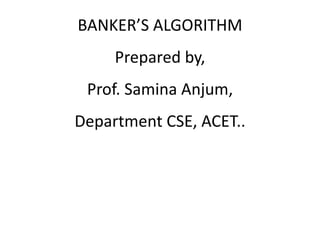
bankers-algorithm2.pptx
- 1. BANKER’S ALGORITHM Prepared by, Prof. Samina Anjum, Department CSE, ACET..
- 2. SYLLABUS:- Operating System UNIT DETAILS I Introduction: Evolution of OS, Types of OS, Basic h/w support necessary for modern operating systems, services provided by OS, system programs and system calls, system design and implementation. II File systems: File concept, Access methods, Disk space management and space allocation strategies, directory structures, Recovery, Log- structured File System, disk arm scheduling strategies. III Scheduling: Process concept, process control block, Types of scheduler, context switch, threads, multithreading model, goals of scheduling and different scheduling algorithms, examples from WINDOWS 2000 & LINUX.
- 3. SYLLABUS:- Operating System UNIT DETAILS IV Memory management: Contiguous allocation, Relocation, Paging, Segmentation, Segmentation with paging, demand paging, page faults and instruction restart , page replacement algorithms , working sets , Locality, Thrashing, Garbage Collection . V Process cooperation and synchronization: Concurrency conditions, Critical section problem, software and hardware solution, semaphores, conditional critical regions and monitors, classical inter process communication problems. VI Deadlocks & Protection: Deadlock definition, Prevention, Avoidance, Detection and recovery, Goals of Protection, access matrix,
- 4. COURSE OUTCOME CO.6 Define deadlock and implement methods for its avoidance, detection and identify goals of protection.
- 5. Banker’s Algorithm • Banker’s Algorithm is used to determine whether a process’s request for allocation of resources be safely granted immediately. or • The grant of request be deferred to a later stage. • For the banker’s algorithm to operate, each process has to a priori specify its maximum requirement of resources. • A process is admitted for execution only if its maximum requirement of resources is within the system capacity of resources. •The Banker’s algorithm is an example of resource allocation policy that avoids deadlock.
- 6. Example:- Consider the following table of a system: Process Allocated Max Available R1 R2 R3 R4 R1 R2 R3 R4 R1 R2 R3 R4 P1 0 0 1 2 0 0 1 2 2 1 0 0 P2 2 0 0 0 2 7 5 0 P3 0 0 3 4 6 6 5 0 P4 2 3 5 4 4 3 5 6 P5 0 3 3 2 0 6 5 2 1. Compute NEED Matrix. 2. Is the system in safe state? Justify.
- 7. Solution:- Consider the following table of the system: Process Allocated Max Available R1 R2 R3 R4 R1 R2 R3 R4 R1 R2 R3 R4 P1 0 0 1 2 0 0 1 2 2 1 0 0 P2 2 0 0 0 2 7 5 0 P3 0 0 3 4 6 6 5 0 P4 2 3 5 4 4 3 5 6 P5 0 3 3 2 0 6 5 2 1. Compute NEED Matrix = ? Need [i] = Max[i] - Allocated[i], Therefore,
- 8. Need Matrix NEED MATRIX R1 R2 R3 R4 P1 0 0 0 0 P2 0 7 5 0 P3 6 6 2 2 P4 2 0 0 0 P5 0 3 2 0
- 9. 2. Is the system is Safe State? By applying the Banker’s Algorithm: Let Avail = Available; i.e . Avail = {2,1,0,0} Iteration 1. Check all processes from P1 to P5. For P1: if (P1 Need < Avail )TRUE then calculate Avail= Avail + Allocated [P1] = {2,1,0,0} + = {0,0,1,2} Avail = {2,1,1,2}
- 10. 2. Is the system is Safe State? By applying the Banker’s Algorithm: Iteration 1. For P2: if (P2 Need < Avail )FALSE //then Check for next process. For P3: if (P3 Need < Avail ) FALSE //then Check for next process.
- 11. 2. Is the system is Safe State? By applying the Banker’s Algorithm: Iteration 1. For P4: if (P4 Need < Avail )TRUE then calculate Avail= Avail + Allocated [P4] = {2,1,1,2} + = {2,3,5,4} Avail = {4,4,6,6}
- 12. 2. Is the system is Safe State? By applying the Banker’s Algorithm: Iteration 1. For P5: if (P5 Need < Avail )TRUE then calculate Avail= Avail + Allocated [P5] = {4,4,6,6} + = {0,3,3,2} Avail = {4,7,9,8}
- 13. 2. Is the system is Safe State? By applying the Banker’s Algorithm: Iteration 2. Check only process P2 to P3. For P2: if (P2 Need < Avail )TRUE then calculate Avail= Avail + Allocated [P2] = {4,7,9,8} + = {2,0,0,0} Avail = {6,7,9,8}
- 14. 2. Is the system is Safe State? By applying the Banker’s Algorithm: Iteration 2. Check only process P2 to P3. For P3: if (P3 Need < Avail )TRUE then calculate Avail= Avail + Allocated [P3] = {6,7,9,8} + = {0,0,3,4} Avail = {6,7,12,12} =System Capacity
- 15. Since, all the processes got TRUE marked, no further iterations are required. Therefore, Safe Sequence = P1, P4, P5, P2 , P3 Therefore, the System is in the Safe State.
- 16. THANKYOU!